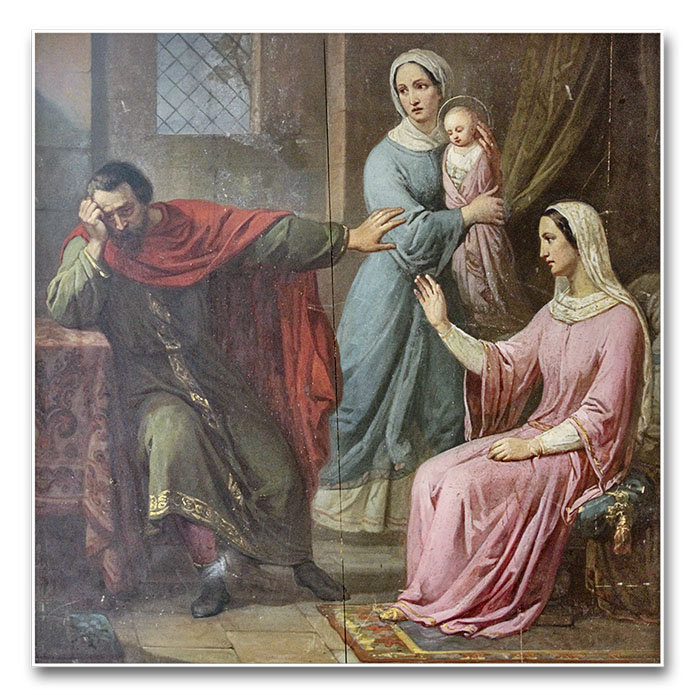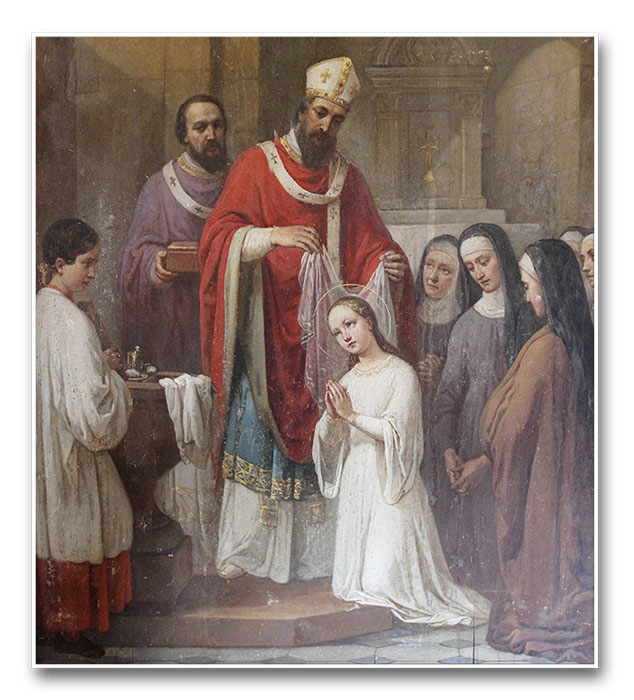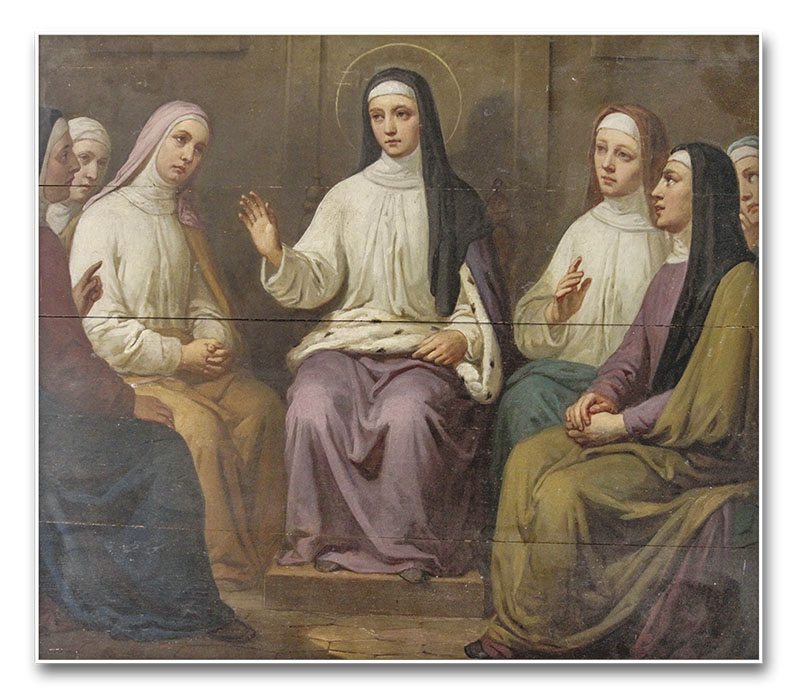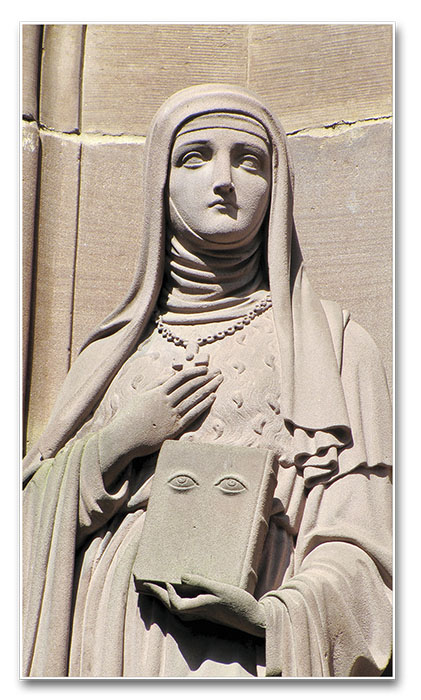The souls who beheld the Saints of the High Middle Ages, whose supernatural sights were far more penetrating than ours, lived immersed in faith. The spiritual and the earthly were intermingled harmoniously in their hearts, giving rise to stories of marvelous events, but whose concrete details could at times be imprecise, or even contradictory.
It is not surprising, therefore, that the life of St. Odile has come to us enveloped in a halo of legend, making it impossible to distinguish clearly between the rigorously historical aspects and the pious nuances that were added to it over subsequent centuries.
These chronicles, nonetheless, certainly reveal to us an entirely singular vocation: in them, we find the pioneering heroism of St. Remigius and St. Clotilde, allied to the fruitful grandeur of Charlemagne. Together with these characteristics, her high calling was marked from an early age by the perplexities and sufferings which this noble Alsatian lady knew how to offer to the Most High as a holocaust of pleasant odor.
Thus, St. Odile was a precursor, guide and model, but also a victim. As such, she undoubtedly played an important historical role in the building up of Christian Europe. Her pain and trials, together with the Redemptive Chalice of Christ, are perhaps the main reason why Alsace, the region of which she is patron, is still today considered one of the most Catholic in France.
Paternal rejection at birth

Shrine of Mont Sainte-Odile, Ottrott (France)
One day in the year 620, silent expectation reigned in the corridors of the castle of Hohenbourg in Alsace, where Duke Adalrich and his wife Bethswinda awaited the birth of a new child. However, far from the fulfilment of the paternal longings for a son, a little girl was born… and blind!
When the Frankish leader saw his dreams vanish, rage dominated his reason, leading him to pronounce a fatal sentence: the child must die. The mother’s intervention spared their daughter’s life, but in exchange he imposed the condition that he never see her again and that no one should know of the blind newborn’s existence, because of the shame this would imply for his lineage.
After asking the Divine Holy Spirit to come to her aid, Bethswinda remembered a faithful servant who could take care of her greatest treasure. This good woman tried in every way to ease her mistress’ sorrow of in view of the sad fate that had befallen the child:
“Weep no more. God has willed that your daughter come into the world like this. But He can give her the light of vision from which He has deprived her. Entrust the child to your servant. I will take care of her and bring her up as God directs.”1
Somewhat relieved by such solicitude, Bethswinda covered her daughter with kisses, blessed her and handed her over to the handmaid amidst tears, saying: “I entrust her to your care, commending her to my Saviour, Jesus Christ.”2
Beginnings of religious life
Thus reads the first page in the story of St. Odile. Her faithful guardian surrounded the little one with such devoted care that a certain curiosity was aroused in the region as to who the illustrious blind girl might be. These rumours reached the ears of Bethswinda, renewing her anxiety and prompting her to seek refuge in prayer. Once again, the Consoler Spirit came to her aid.
In the seventh century, monasteries were not only a safe haven for the unfortunate, but they were also the place where children of the noblest dynasties were given an excellent education. With this in mind, Bethswinda sent her daughter to the convent of Palma, a few miles from Besançon, where an aunt of hers was the head of the flourishing community. Without revealing the origin of the newcomer, the superior received the little blind girl with great tenderness and piety, discerning that God’s designs hovered over that soul marked from the cradle by suffering.
Thus, the Saint grew up under the influence of the gentle yoke of monastic life, which easily opened her soul to divine realities. According to almost all the chroniclers, it was around the age of thirteen that the event took place that changed the course of her life.
A miraculous cure at Baptism

Shrine of Mont Sainte-Odile, Ottrott (France)
In the then-nascent Catholic Europe, many monks were anointed bishops out of apostolic necessity, returning to the monastery after completing their mission. Among these were two brothers of Germanic origin: St. Hidulf, Bishop of Trier, who founded the Abbey of Moyenmoutier around 671, and St. Erhard, Bishop of Ratisbonne, who belonged to the aforementioned category of missionary monks.
One day, being at the monastery in Regensburg, Erhard had a vision: “‘Arise,’ the Lord said to him, ‘and go to the monastery of Palma: there you will find a virgin born blind. You will baptize her in the name of the Most Holy Trinity, and after Baptism the blind virgin will see the light of day.’”3 The holy bishop set forth immediately and met Hidulf on the way, who had been mystically informed of his brother’s mission. Together they proceeded to Palma, and as soon as they arrived at the convent, they asked to see the girl.
Deeply touched to take part in the fulfilment of the divine plan for the child, the brothers prayed to the Lord to grant “the light of grace to her soul and the light of day to her body.”4 When all the preparations for the Baptism had been made, the catechumen was examined on the mysteries of the Faith, leaving everyone in awe at the wisdom of her answers.
Finally, the ceremony began. After Bishop Erhard had solemnly pronounced the sacramental words, he took the holy oils and, anointing the eyes of the blind girl, said: “In the name of Our Lord Jesus Christ, may your body see as your soul does.”5 Immediately the girl was able to see, and for a long time she remained with her eyes raised heavenward. Inexpressible emotion took hold of those present as they witnessed such a great wonder. It was then that the virgin of Palma received the name Odile, which means Light of God, as indicated by the Lord in the vision that the Bishop of Trier had seen.
St. Hidulf carried the good tidings of the miracle to Duke Adalrich, but his attitude was unbending: he did not and would not recognize her as his daughter.
Return to her family home
The years passed and the servant to whom Bethswinda had entrusted the care of Odile when she was a little girl fell seriously ill. Before dying, she told the virgin of her true origin, awakening in her a great desire to meet her family.
One winter’s day, some knights stopped at the convent and, as they were warmed by the soup and some good wine, they talked during their meal about the Duke of Hohenbourg, the virtues of his wife and the children of the noble couple. Having overheard them, Odile wrote a letter that very evening to one of her brothers, named Hugo. She told him her story and asked for his help in returning to their father’s house.
Upon reading the letter, her brother went to share his joy with his father, who, when he realized what was afoot, loudly proclaimed his usual denial. Nevertheless, Hugo made up his mind to bring his sister back secretly.
One day, father and son were on the terrace of the castle when they saw a detachment arrive. Hugo then revealed to the duke his enterprise, confessing that he had sent an escort to pick up his sister at the convent of Palma. Enraged, Adalrich unleashed such a violent blow on him that he left the young man senseless for some time. While he received the necessary care, Odile reached the lofty mountain where Hohenbourg was located.
When she descended from the carriage, Odile threw herself into the arms of her mother, who received her with transports of joy and affection, together with her brothers. Only Adalrich did not share in the general delight and, unyielding in the face of the grim remorse that assailed his soul, he once again demanded that his daughter keep out of his sight. It was virtually a second exile…
The young woman, undaunted, accepted and kissed the cross which Providence had given her with a wholly supernatural spirit, giving thanks to God for so many favours of which she did not consider herself worthy.
At the court of Hohenbourg
Odile knew that she could contribute to God’s plans by doing good not only to those closest to her, but also to all those within the reach of her zeal and charity.
One cold night, having gone out to distribute food to the needy, she was unexpectedly met by Adalrich as she struggled to walk in the snow. Seeing her noble deed, the Duke’s obstinacy was finally broken down, and coming to his senses, he realized how unjust and cruel his attitude towards his virtuous young daughter had been. The next day, he lavished upon her all of her rights as his legitimate daughter, until then withheld: he had her dressed in fine clothes, gave her a white steed and had her sit at the table with the nobles.
Life at court began for Odile, and all were dazzled by her beauty and nobility of soul. One day a Germanic prince asked Duke Adalrich for his daughter’s hand. At the moment in which her father was about to announce to her the news, Odile cut him short by saying that she wished to return to the convent of Palma, in order to dedicate herself to religious life, for she missed the monastic peace, the study of Scripture, the pious emulation of the ways of the Lord… Naturally, her father was adamant that she accept the proposal of the illustrious suitor.
Complete surrender into the hands of Providence
In the face of this new trial, St. Odile was forced to flee the castle at night, disguised as a peasant. The next day, when he realized his daughter was missing, Adalrich rounded up a retinue and set out in pursuit of her. He imagined that he would easily find her, but he did take God’s intervention into account.
After crossing the Rhine with the help of a boatman, Odile sought refuge in the mountains. Arriving at the place today called Musbachtal, near the city of Freiburg im Breisgau, in present-day Germany, she sat down exhausted, leaning on a rock. Suddenly she heard the noise of horses approaching and for a moment she thought all was lost…
However, at the moment when the detachment was just a few metres away, her confidence became steadfast as a bulwark. Then the stone behind her opened to offer her refuge, closing as soon as Odile had entered. When the danger had passed, it once again opened to set her free. In order to seal the prodigy wrought on behalf of his faithful servant, God made a spring gush forth from the opening in the rock.
Odile began to live off of her handiwork. She travelled from village to village, never ceasing to do good to those in need. Time passed and at Hohenbourg castle no one had heard any news from the young woman. But her suitor, learning of her activities, sent word to Adalrich that he was withdrawing from the engagement. The latter, in turn, was struck with a sorrow that grew every day and, afflicted with remorse for his past wrongdoings, sent heralds to proclaim throughout the kingdom that he was awaiting the return of his daughter Odile and that he would respect her desire to be a religious, if this was truly her wish.
Without delay she returned to the castle, giving thanks to God for the new situation.
The monastery of Hohenbourg

Shrine of Mont Sainte-Odile, Ottrott (France)
This time, Adalrich promised his daughter to do everything in his power to fulfil her desire to follow the religious path. To this end, he adapted the Castle of Hohenbourg to monastic life and granted it to Odile. It was an ideal setting, being the highest elevation in the region, with a panoramic view that was conducive to recollection and contemplation.
Before long, the sonorous hunting horns and festive dances gave way to the chanting of the hours and prayer. Many young people followed Odile’s example, and it was not long before the Saint and her religious community, in the presence of the whole ducal family, were consecrated by the Bishop of Alsace and took solemn vows.
Among the various chapels that Odile built afterwards, she was especially fond of the one dedicated to St. John the Baptist. Before having it built, she had asked the Precursor to indicate the most suitable site for it, and one night he appeared to her cloaked in light and indicated the place that pleased him. There the holy abbess would be favored with many visions of heavenly mysteries which, unfortunately, have not come down to us.
The fragrance of Odile’s sanctity spread throughout the region. Healings, conversions and the multiplication of food drew noblemen and commoners alike to the heights of Hohenbourg. However, many sick and crippled people did not have the strength to make the ascent. Out of concern for them, St. Odile decided to found a new monastery at the foot of the mountain called Niedermunster – the convent below – in order to provide them with the lodging and care they needed.
Thus the years passed, the number of nuns increased and the sick recovered not only their bodily health, but also that of their souls. This was the great goal of St. Odile: to lead others to eternal salvation. A saint’s actions in offering material help to others also has the effect of setting the spiritual dimension in order, that is, to help the person to “be in order with God.” This brings peace of soul, along with the desire for goodness to be spread and evil to be eliminated. This is true charity.
Having crossed the threshold of eternity, she receives the Viaticum

Strasbourg (France)
Finally, on December 13, 720 Odile realized that she had reached the end of her worldly course. Gathering the nuns, she told them:
“Remain very united; always live in simplicity and humility, and have a living faith. When you are tempted, pray; work unceasingly to be better each day. Never forget that, like me, you will come to the end of this life’s journey you will have to give an account of all your thoughts, words and actions.”
Then, desiring to be alone with God, she asked them to withdraw to the nearby chapel and sing the Psalms. When they returned, they found that the holy abbess had abandoned this earth. Dismayed that their spiritual mother had not received Viaticum before leaving for eternity, they prayed to God and He allowed Odile to return to the world of the living to receive the King of kings and Lord of lords for the last time.
Seed of Christian Civilization
God demands great renunciations of certain souls who have high callings, such as that of the patroness of Alsace.
From the very beginning of their lives, they are invited to embrace the good entirely and to detach themselves from all else, including themselves. Although they feel called to soar like eagles, often the Most High also asks them to walk step by step, making it possible with their sacrifice for others to glimpse the same grandiose horizons they contemplate.
At the time of St. Odile, the splendours of Christian civilization were only beginning to emerge, but in the soul of this abbess of Carolingian calibre they already dwelt in their fullness, just as a mighty tree can be found in the seed that gave rise to it.
St. Odile was born blind, but became an eagle. While her eyes remained closed at the beginning of her earthly life, her intrepid spirit never stopped soaring to God. ◊
Taken from the Heralds of the Gospel magazine, #158.
1 WINTERER, Landelin. Histoire de Sainte Odile. Paris-Guebwiller: Ch. Douniol; Jung, 1869, p.46.
2 Idem, ibidem.
3 Idem, p.54.
4 Idem, p.56.
5 Idem, p.57.
